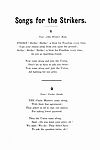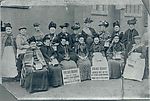 Mary Macarthur rallying the crowd in Cradley Heath
Mary Macarthur rallying the crowd in Cradley Heath A crowded meeting, Express and Star 23.8.1910
A crowded meeting, Express and Star 23.8.1910 Workers withdraw signatures, Daily News 25.8.1910
Workers withdraw signatures, Daily News 25.8.1910 Slaves of the Forge, Daily Express, 1.9.1910
Slaves of the Forge, Daily Express, 1.9.1910 Confident of success, Express and Star, 27.8.1910
Confident of success, Express and Star, 27.8.1910 Women on strike, Midland Evening News 31.8.1910
Women on strike, Midland Evening News 31.8.1910 They sang as they marched
They sang as they marched England's Disgrace
England's Disgrace Meeting outside the Empire Theatre
Meeting outside the Empire Theatre Leaving the Empire Theatre carrying free loaves of bread
Leaving the Empire Theatre carrying free loaves of bread

The Chain Trade Board had decided on a minimum wage for the women chainmakers. Many employers tried to avoid paying the new rates. Mary Macarthur called a strike and set about gathering support from all round the country. Julia Varley, Thomas and Charles Sitch led the campaign in Cradley Heath. It took ten weeks, but the strike was a success, and the women chainmakers received what was rightfully theirs.
Strikes were not unusual at this time, but organising the women chainmakers was not an easy task. Their workshops were scattered, making communication difficult. More than half the women were not in a union. They could not afford the weekly 3d (1.5p) subscription. No-one, not even Mary Macarthur, knew if they could raise enough money to keep the women out on strike. Even so, after listening to Mary's rousing speeches, they said that they would rather drop dead than give in.
STRIKE TIMETABLE
21st AUGUST 1910: The strike began. The first meeting was held at Graingerâs Lane Primitive Methodist School, and was attended by 400 women.
27th AUGUST 1910: Over 300 of the women chainmakers, who were union members, met at Graingerâs Lane School for their first weekâs strike pay of 5s (25p) each. Later, as the strike fund grew, the amount increased to 6s (30p) per week. Non-union members received 4s (20p).
31st AUGUST 1910: The number of women on strike reached 648.
2nd SEPTEMBER 1910: One of the many processions took place through Cradley Heath. âDay by day, night by night, there were processions with hammers and torches, bands and collectors of pennies". (Hamilton, 1925, p87) As the women marched they sang hymns and strike songs.
People standing by, nearly all men, watched as the procession passed. âThey wished well, very dumbly, in the presence of this new thing, as if they found it queer that women should be doing something for themselves; queer and rather dangerous.â (John Galsworthy, 1910)
Strikers also marched to Old Hill, to demonstrate outside the Public Offices, where a meeting was being held of the Chain Manufacturersâ Association. Many of the marchers carried placards,
3rd SEPTEMBER 1910: The Cradley Heath Town Band led a march to Old Hill, where the demonstrators persuaded the coil chainmakers there, to âthrow down their hammersâ. They joined the strike, and brought the total up to 800.
6th SEPTEMBER 1910: Trinder and Co. agreed to pay the new rates. 120 women returned to work. The number on strike began to dwindle.
12th â 16th SEPTEMBER 1910: Women chainmakers visited the Trade Union Congress held in Sheffield. They appeared on stage holding up their chains. The photograph above shows them outside the building. Julia Varley is on the far right, and Mary Macarthur, who introduced the deputation, is shown without a hat.
3rd OCTOBER 1910: Another procession marched through Cradley Heath, from the Station to The Empire Theatre. Free bread was distributed at the meeting. In the photograph above you can see women carrying the loaves as they leave the Theatre.
19th OCTOBER 1910 The last meeting of the strike was held at Graingerâs Lane School. The strike was at an end. Most employers had signed the âwhite listâ, a register of manufacturers prepared to pay the new rates. The Employersâ Association agreed to deal only with those middlemen, who had also signed the list. J.J. Mallon, the Secretary of the Anti-Sweating League, described this last meeting as unusually quiet, "like a prayer meeting."
22nd OCTOBER 1910 The strike ended in victory for the women chainmakers of Cradley Heath. Mary Macarthur returned to the town a few months later. The women presented her with a gold bracelet watch. Over 2,000 women were there to greet and thank her, and for once, their heroine was lost for words.
Rollover the captions in the box to see the available images in thumbnail format, click the caption to see the full-size image
| Reference: | 727 |
| Keywords: | |
| Archive Ref: | |
| Updated: | Thu 12 Jul 2007 - 0 |
| Interpretation written by | Barbara Harris |
| Author's organisation | |
| Organisation's website |